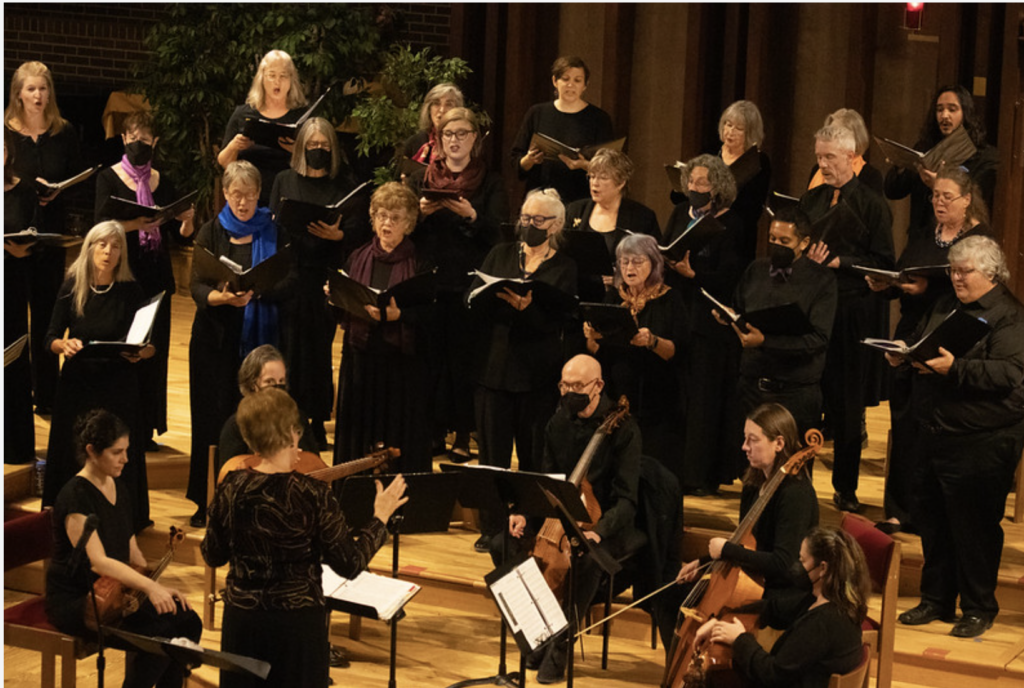MELODY AT CENTER OF SEICENTO FOUNDER’S FINAL CONCERT
Guest harpsichordist joins baroque vocal ensemble
A preview by Kelly Dean Hansen, April 1, 2024
Evanne Browne started the Boulder-based Seicento Baroque Ensemble in 2011 to share her passion for the often-neglected music of the 17th Century. She explains that this is beautiful music audiences will not hear elsewhere, performed in a historically informed way with period instruments. The group has flourished, even as Browne departed as director, then returned for the last two seasons.
Her second stint will close with a series of concerts called “Prima Melodia,” to be played in Denver, Boulder, and Longmont April 26-28. Browne, who announced her retirement after this interview was conducted, explained that the concert title reflects the new focus in the early baroque.
“The importance of melody above a bass line with harmonies was a contrast both with the Renaissance and with the later styles of Bach and Handel,” Browne said. “I’m emphasizing that with a program of Italian music because Italy is where this style started.” One featured work by Girolamo Frescobaldi is a mass based on a secular tune. The subject of that tune is a little girl who does not want to become a nun.
That same tune, elaborated with ornamental divisions and variations, is the basis of an instrumental piece by Alessandro Piccini that will be played as a lute solo by guest artist William Simms, one of the guest instrumentalists on the program.
Browne said that the importance of emotional expression in the melodic line led to vocal techniques that are much more difficult than those of the periods coming before and after the early baroque. “There is just a lot more that is demanded from the singers,” she said. “I’ve chosen some pieces with fast runs and other techniques that are new, repertoire that other groups will not explore.”
Seicento’s core choir is augmented by professional soloists and apprentice artists, an aspect particularly emphasized by Browne. “They need a chance to do this kind of music and to work with a choir that specializes in it,” she said. The apprentice artists will participate in the choir in addition to taking on solo roles, including some chamber duets and trios.
Other pieces on the program include works by the most famous composer of the period, Claudio Monteverdi, as well as his successor as music director, or “maestro di capella” at St. Mark’s Basilica in Venice, Giovanni Rovetta. Browne said that Rovetta is a composer who is completely new to her. Guest recorder player Linda Lunbeck will take the melodic line on a series of divisions on a madrigal by Renaissance composer Cipriano de Rore, those elaborations to the madrigal having been added by someone else in the early baroque.
The main distinguished guest artist on the “Prima Melodia” concert is harpsichordist Webb Wiggins, who served as professor of harpsichord at the Oberlin College Conservatory of Music for 11 years and coordinated the early music program at the Peabody Conservatory of Music for 20 years. “He’s at a point where he just wants to play for good things, and he’s coming as a favor to me” Browne said.
Wiggins will play some solo pieces and will take on the important “continuo” role accompanying the choir as well as vocal and other instrumental soloists, including Lunbeck. He spoke about the role of the continuo in the early baroque as opposed to its more familiar use in the early 18th century.
“By Bach’s time, the continuo playing was pretty straightforward,” Wiggins said. “It’s based on harmony, with a thicker texture and at least three voices.” But in the early baroque, coming out of the heavily polyphonic Renaissance style, it was new and probably much thinner, Wiggins said. Later baroque composers used “figures,” or numbers to indicate the harmony to be played above the bass note. Wiggins said that in earlier pieces without such figures, the player needs to be careful about not adding too much. “You don’t want to confuse the linear activity of the vocal melody with the accompaniment,” he said. “There might be more activity in the right hand to help the singer out, as opposed to more active lines below.”
Wiggins also stressed the importance of playing Italian music on an Italian instrument, just as he would prefer to play French music on a French harpsichord. “The instruments have different colors,” Wiggins said. “My concept of French baroque music is low and dark, but round sounds. Italian music has more edges, a more pointed and articulate sound.” He said that this reflects the differences in the two languages. “In Italian, you want to be strong with consonants. An Italian harpsichord has a short, resonating, percussive sound with a more distinct pluck, but the tone decays faster than that of a French instrument, whose pluck sound is much softer.”
He said that the Italians stressed the top of the texture, reflecting the focus on melody, and that this is reflected in their construction of the instrument. Like Browne, Wiggins has a deep love for the music of the early baroque, including French, Italian, and German composers. “I don’t like to focus on the standard baroque fare,” he said, referring to later composers such as François Couperin, Dominico Scarlatti, or Bach. As Browne said, that contrast with the later generation is at the heart of this “Prima Melodia” program.
Tickets are available for the April 26-28 performances by clicking here.
Performances:
- Friday, April 26, 7:30 p.m., St. Paul’s Lutheran Church, 1600 Grant Ave., Denver.
- Note: The April 26 concert will also be simulcast, with access to the simulcast availble for a fee online.
- Saturday, April 27, 7:30 p.m., Mountain View United Methodist Church, 355 Ponca Place, Boulder.
- Sunday, April 28, 3 p.m., United Church of Christ Longmont, 1500 9th Ave., Longmont.












